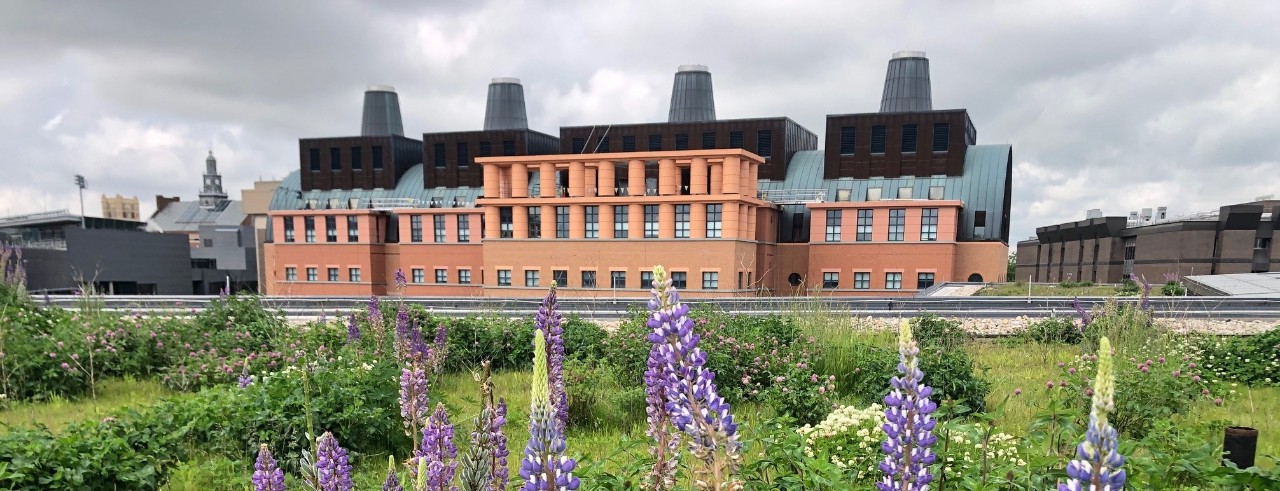
UC students create solutions for environmental challenges
Engineering team wins second place in organic waste management competition
University of Cincinnati students won second place in the Environmental Challenge International Competition hosted by the Air and Waste Management Association (AWMA). The contest asked students to propose effective solutions to an environmental problem relevant to the “host” site, San Francisco, for the AWMA 2020 conference.
Teams presented their solutions to the challenge, “The Intersection of Climate Change and Organic Waste Management,” to environmental professionals at the AWMA conference in July, which was held virtually this year.

The BEST team made a virtual presentation to a panel of experts sharing their solution to organic waste management needs. Photo/provided.
The UC Bearcat Environmental Solutions Team (BEST) comprised Andres Mata, chemical engineering graduate student who served as team lead, Sophia Pedigo, environmental engineering undergraduate student, and Kevin Johnson, chemical engineering undergraduate student.
Student teams had to develop a national, state or local organic waste management program that would divert and recycle organic materials, such as food waste, to reduce methane emissions. Methane is a major pollutant exacerbating climate change impacts. Teams researched existing and proposed policies, laws and regulations on the topic, including California’s recent legislation, including AB 32 and SB 1383, requiring organic materials to be diverted from landfills to reduce greenhouse gas emissions.
Based on their research, the team decided to propose using anaerobic digestion of food waste at wastewater treatment plants. This is a process in which microorganisms break down biodegradable material, like food waste, that is starved of oxygen. What remains can be used as fertilizer or biogas instead of sitting in a landfill.
The team’s adviser, Mingming Lu, professor of environmental engineering, is also the faculty adviser of the UC student chapter of AWMA. The chapter has a strong tradition of attending the AWMA annual conference and engaging students with various activities. Mata is a graduate research assistant in Lu’s lab and he also presented the lab’s research during the conference. Johnson is an undergraduate researcher in the lab and Pedigo had been in contact with Lu throughout her freshman year because she was interested in Lu’s work.
Lu’s research includes developing processes to create useful materials from waste feedstocks, such as biodiesel from used cooking oil, waste grease and spent coffee grounds.
“I think that our background in this industry from conducting this research was very helpful in providing us insight,” Johnson said.
While some other competing teams also had the idea to use digestion to break down food waste, Mata said he thinks it was his team’s plan to utilize wastewater treatment plants—which would allow the plan to be implemented in many communities—that set them apart and helped them nab a second-place honor.
Working remotely because of the coronavirus pandemic, each team member focused on one major area for their presentation: economic, legislative and technical. They met frequently via Zoom videoconferencing from late May through June.
“The project allowed me to further my knowledge of food waste, hone my skills as a team member, and learn more about the processes of writing a proposal,” Pedigo said.
The opportunity allowed the team to exercise their problem-solving skills and think outside the box, which Mata said is always valuable in research and in industry.
“I feel that whenever I approach a problem now, I will keep in mind the economic and legislative implications of it, not just the technical,” Mata said. “As a graduate student, it’s easy to forget that our research must be able to be applied in the business world if we ever hope for it to leave the lab.”

The team, including Andres Mata (shown), came up with a plan to divert food waste from communities to be broken down to create biogas and fertilizer. Photo/provided.
Featured image at top: Engineering Research Center as seen from the green roof atop Lindner Hall. Photo/John Martini/UC.
Related Stories
UC student breaks world record in competitive speedcubing
December 19, 2025
UC computer science student Sujan Feist set a new world record in speedcubing at competition this month in Coshocton, Ohio. Feist is the reigning world champion in the 2x2 division.
UC undergraduate collaborates with Swiss university on drone research
December 19, 2025
Prissha Chawla, undergraduate student at the university of Cincinnati, is double majoring in computer science and statistics at the College of Engineering and Applied Science and College of Arts and Sciences. Now preparing to graduate in the spring of 2026, Chawla’s journey at UC has been full of impactful experiences. Since she arrived, she has had the opportunity to participate in a new international exchange program with a university in Switzerland, present at an international conference in Prague, co-op with Delta Air Lines, and much more.
PhD student uses engineering to understand cardiovascular system
December 17, 2025
Drawn to the University of Cincinnati for the strong reputation in cardiovascular research and the connections with the UC Medical Center, Shrayesh Manegaonkar is pursuing a PhD in mechanical engineering at the College of Engineering and Applied Science. Recently, he was named Graduate Student Engineer of the Month for his work on biofluid mechanics, aiming to develop better diagnostic tools for cardiovascular diseases.
